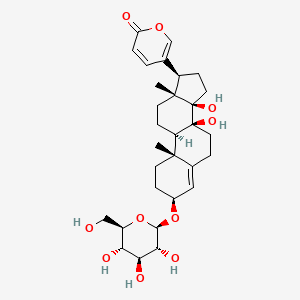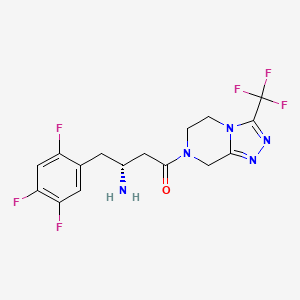
Sitagliptina
Descripción general
Descripción
- Cabe destacar que la this compound tiene la ventaja de tener buenos perfiles de seguridad, bajas tasas de hipoglucemia y un aumento mínimo de peso .
Sitagliptina: pertenece a la clase de los inhibidores de la dipeptidil peptidasa-4 (DPP-4). Se puede utilizar solo o en combinación con otros fármacos antidiabéticos orales para controlar la diabetes tipo 2.
Mecanismo De Acción
Inhibición de la DPP-4: La sitagliptina inhibe la DPP-4, una enzima que degrada rápidamente las hormonas incretinas, como el péptido similar al glucagón-1 (GLP-1) y el péptido insulinotrópico dependiente de la glucosa (GIP).
Aumento del GLP-1 y el GIP: Al inhibir la DPP-4, la this compound aumenta los niveles de GLP-1 y GIP activos. Estas hormonas potencian la liberación de insulina y reducen la secreción de glucagón de forma dependiente de la glucosa.
Efectos clínicos: En pacientes con diabetes tipo 2, la this compound reduce los niveles de HbA1c, glucosa en ayunas y glucosa posprandial.
Aplicaciones Científicas De Investigación
Química: Los investigadores estudian la reactividad, la estabilidad y las interacciones de la sitagliptina con otros compuestos.
Biología: En la investigación biológica, se investigan los efectos de la this compound sobre el metabolismo de la glucosa, la secreción de insulina y la función pancreática.
Medicina: Los ensayos clínicos exploran su eficacia en el control de los niveles de azúcar en sangre y en la prevención de las complicaciones asociadas a la diabetes.
Industria: Las empresas farmacéuticas utilizan la this compound en el desarrollo de medicamentos antidiabéticos.
Análisis Bioquímico
Biochemical Properties
Sitagliptin plays a crucial role in biochemical reactions by inhibiting the enzyme dipeptidyl peptidase-4 (DPP-4). This inhibition prevents the degradation of incretin hormones, such as glucagon-like peptide-1 (GLP-1) and glucose-dependent insulinotropic polypeptide (GIP). By maintaining higher levels of these hormones, sitagliptin enhances insulin secretion and suppresses glucagon release, thereby improving glycemic control .
Cellular Effects
Sitagliptin affects various types of cells and cellular processes. In pancreatic beta cells, it enhances insulin secretion in response to meals, while in alpha cells, it suppresses glucagon release. This dual action helps to regulate blood glucose levels more effectively. Additionally, sitagliptin has been shown to improve beta-cell function and survival, which is crucial for long-term diabetes management .
Molecular Mechanism
At the molecular level, sitagliptin exerts its effects by binding to and inhibiting the DPP-4 enzyme. This inhibition prevents the breakdown of incretin hormones, leading to increased levels of GLP-1 and GIP. These hormones then bind to their respective receptors on pancreatic cells, triggering a cascade of signaling pathways that result in increased insulin secretion and decreased glucagon release .
Temporal Effects in Laboratory Settings
In laboratory settings, the effects of sitagliptin have been observed to change over time. Studies have shown that sitagliptin remains stable and effective over extended periods, with consistent improvements in glycemic control observed in both in vitro and in vivo studies. Long-term use of sitagliptin has been associated with sustained improvements in HbA1c levels and beta-cell function .
Dosage Effects in Animal Models
In animal models, the effects of sitagliptin vary with different dosages. Low to moderate doses of sitagliptin have been shown to improve glycemic control without significant adverse effects. At higher doses, some toxic effects, such as gastrointestinal disturbances and renal impairment, have been observed. These findings highlight the importance of optimizing dosage to balance efficacy and safety .
Metabolic Pathways
Sitagliptin is primarily excreted unchanged in the urine, with minimal metabolism occurring in the liver. The minor metabolic pathways involve cytochrome P450 enzymes, particularly CYP3A4 and CYP2C8. These pathways result in the formation of inactive metabolites, which are then excreted in the urine and feces .
Transport and Distribution
Sitagliptin is transported and distributed within cells and tissues through various mechanisms. It is a substrate for p-glycoprotein, which facilitates its transport across cell membranes. Additionally, sitagliptin has been shown to enhance the translocation of glucose transporter-4 (Glut4) to the cell membrane, improving glucose uptake in muscle and adipose tissues .
Subcellular Localization
Sitagliptin’s subcellular localization is primarily within the cytoplasm, where it interacts with the DPP-4 enzyme. This interaction prevents the degradation of incretin hormones, allowing them to exert their effects on insulin and glucagon secretion. The localization of sitagliptin within the cytoplasm is crucial for its inhibitory action on DPP-4 and subsequent regulation of blood glucose levels .
Métodos De Preparación
Rutas sintéticas: La sitagliptina se sintetiza a través de varias etapas químicas. Una ruta sintética común implica la condensación de un derivado de aminoácido (3-amino-1-adamantanol) con un derivado cianoacetilo (cianoguanidina). Esta reacción produce la estructura central de la this compound.
Producción industrial: La producción industrial de this compound implica la síntesis a gran escala utilizando condiciones optimizadas. El proceso suele incluir pasos de purificación para obtener this compound de alta pureza para uso farmacéutico.
Análisis De Reacciones Químicas
Reactividad: La sitagliptina sufre varias reacciones químicas, incluidas reacciones de oxidación, reducción y sustitución.
Reactivos y condiciones comunes: Los reactivos y condiciones específicos dependen de la transformación deseada. Por ejemplo
Productos principales: Los productos principales formados durante estas reacciones incluyen intermedios y derivados finales de la this compound.
Comparación Con Compuestos Similares
Singularidad: La sitagliptina es única al ser el primer inhibidor de la DPP-4 utilizado para el tratamiento de la diabetes tipo 2.
Compuestos similares: Otros inhibidores de la DPP-4 incluyen vildagliptina, saxagliptina y linagliptina.
Propiedades
IUPAC Name |
(3R)-3-amino-1-[3-(trifluoromethyl)-6,8-dihydro-5H-[1,2,4]triazolo[4,3-a]pyrazin-7-yl]-4-(2,4,5-trifluorophenyl)butan-1-one | |
|---|---|---|
| Source | PubChem | |
| URL | https://pubchem.ncbi.nlm.nih.gov | |
| Description | Data deposited in or computed by PubChem | |
InChI |
InChI=1S/C16H15F6N5O/c17-10-6-12(19)11(18)4-8(10)3-9(23)5-14(28)26-1-2-27-13(7-26)24-25-15(27)16(20,21)22/h4,6,9H,1-3,5,7,23H2/t9-/m1/s1 | |
| Source | PubChem | |
| URL | https://pubchem.ncbi.nlm.nih.gov | |
| Description | Data deposited in or computed by PubChem | |
InChI Key |
MFFMDFFZMYYVKS-SECBINFHSA-N | |
| Source | PubChem | |
| URL | https://pubchem.ncbi.nlm.nih.gov | |
| Description | Data deposited in or computed by PubChem | |
Canonical SMILES |
C1CN2C(=NN=C2C(F)(F)F)CN1C(=O)CC(CC3=CC(=C(C=C3F)F)F)N | |
| Source | PubChem | |
| URL | https://pubchem.ncbi.nlm.nih.gov | |
| Description | Data deposited in or computed by PubChem | |
Isomeric SMILES |
C1CN2C(=NN=C2C(F)(F)F)CN1C(=O)C[C@@H](CC3=CC(=C(C=C3F)F)F)N | |
| Source | PubChem | |
| URL | https://pubchem.ncbi.nlm.nih.gov | |
| Description | Data deposited in or computed by PubChem | |
Molecular Formula |
C16H15F6N5O | |
| Source | PubChem | |
| URL | https://pubchem.ncbi.nlm.nih.gov | |
| Description | Data deposited in or computed by PubChem | |
DSSTOX Substance ID |
DTXSID70197572 | |
| Record name | Sitagliptin | |
| Source | EPA DSSTox | |
| URL | https://comptox.epa.gov/dashboard/DTXSID70197572 | |
| Description | DSSTox provides a high quality public chemistry resource for supporting improved predictive toxicology. | |
Molecular Weight |
407.31 g/mol | |
| Source | PubChem | |
| URL | https://pubchem.ncbi.nlm.nih.gov | |
| Description | Data deposited in or computed by PubChem | |
Physical Description |
Solid | |
| Record name | Sitagliptin | |
| Source | Human Metabolome Database (HMDB) | |
| URL | http://www.hmdb.ca/metabolites/HMDB0015390 | |
| Description | The Human Metabolome Database (HMDB) is a freely available electronic database containing detailed information about small molecule metabolites found in the human body. | |
| Explanation | HMDB is offered to the public as a freely available resource. Use and re-distribution of the data, in whole or in part, for commercial purposes requires explicit permission of the authors and explicit acknowledgment of the source material (HMDB) and the original publication (see the HMDB citing page). We ask that users who download significant portions of the database cite the HMDB paper in any resulting publications. | |
Solubility |
3.40e-02 g/L | |
| Record name | Sitagliptin | |
| Source | Human Metabolome Database (HMDB) | |
| URL | http://www.hmdb.ca/metabolites/HMDB0015390 | |
| Description | The Human Metabolome Database (HMDB) is a freely available electronic database containing detailed information about small molecule metabolites found in the human body. | |
| Explanation | HMDB is offered to the public as a freely available resource. Use and re-distribution of the data, in whole or in part, for commercial purposes requires explicit permission of the authors and explicit acknowledgment of the source material (HMDB) and the original publication (see the HMDB citing page). We ask that users who download significant portions of the database cite the HMDB paper in any resulting publications. | |
Mechanism of Action |
Inhibition of DPP-4 by sitagliptin slows DPP-4 mediated inactivation of incretins like GLP-1 and GIP. Incretins are released throughout the day and upregulated in response to meals as part of glucose homeostasis. Reduced inhibition of incretins increase insulin synthesis and decrease glucagon release in a manner dependant on glucose concentrations. These effects lead to an overall increase in blood glucose control which is demonstrated by reduced glycosylated hemoglobin (HbA1c)., Januvia is a member of a class of oral anti-hyperglycemic agents called dipeptidyl peptidase 4 (DPP-4) inhibitors. The improvement in glycemic control observed with this medicinal product may be mediated by enhancing the levels of active incretin hormones. Incretin hormones, including glucagon-like peptide-1 (GLP-1) and glucose-dependent insulinotropic polypeptide (GIP), are released by the intestine throughout the day, and levels are increased in response to a meal. The incretins are part of an endogenous system involved in the physiologic regulation of glucose homeostasis. When blood glucose concentrations are normal or elevated, GLP-1 and GIP increase insulin synthesis and release from pancreatic beta cells by intracellular signaling pathways involving cyclic AMP. Treatment with GLP-1 or with DPP-4 inhibitors in animal models of type 2 diabetes has been demonstrated to improve beta cell responsiveness to glucose and stimulate insulin biosynthesis and release. With higher insulin levels, tissue glucose uptake is enhanced. In addition, GLP-1 lowers glucagon secretion from pancreatic alpha cells. Decreased glucagon concentrations, along with higher insulin levels, lead to reduced hepatic glucose production, resulting in a decrease in blood glucose levels. The effects of GLP-1 and GIP are glucose-dependent such that when blood glucose concentrations are low, stimulation of insulin release and suppression of glucagon secretion by GLP-1 are not observed. For both GLP-1 and GIP, stimulation of insulin release is enhanced as glucose rises above normal concentrations. Further, GLP-1 does not impair the normal glucagon response to hypoglycemia. The activity of GLP-1 and GIP is limited by the DPP-4 enzyme, which rapidly hydrolyzes the incretin hormones to produce inactive products. Sitagliptin prevents the hydrolysis of incretin hormones by DPP-4, thereby increasing plasma concentrations of the active forms of GLP-1 and GIP. By enhancing active incretin levels, sitagliptin increases insulin release and decreases glucagon levels in a glucose-dependent manner. In patients with type 2 diabetes with hyperglycemia, these changes in insulin and glucagon levels lead to lower hemoglobin A1c (HbA1c) and lower fasting and postprandial glucose concentrations. The glucose-dependent mechanism of sitagliptin is distinct from the mechanism of sulfonylureas, which increase insulin secretion even when glucose levels are low and can lead to hypoglycemia in patients with type 2 diabetes and in normal subjects. Sitagliptin is a potent and highly selective inhibitor of the enzyme DPP-4 and does not inhibit the closely-related enzymes DPP-8 or DPP-9 at therapeutic concentrations., Sitagliptin is a DPP-4 inhibitor, which is believed to exert its actions in patients with type 2 diabetes by slowing the inactivation of incretin hormones. Concentrations of the active intact hormones are increased by Januvia, thereby increasing and prolonging the action of these hormones. Incretin hormones, including glucagon-like peptide-1 (GLP-1) and glucose-dependent insulinotropic polypeptide (GIP), are released by the intestine throughout the day, and levels are increased in response to a meal. These hormones are rapidly inactivated by the enzyme, DPP-4. The incretins are part of an endogenous system involved in the physiologic regulation of glucose homeostasis. When blood glucose concentrations are normal or elevated, GLP-1 and GIP increase insulin synthesis and release from pancreatic beta cells by intracellular signaling pathways involving cyclic AMP. GLP-1 also lowers glucagon secretion from pancreatic alpha cells, leading to reduced hepatic glucose production. By increasing and prolonging active incretin levels, Januvia increases insulin release and decreases glucagon levels in the circulation in a glucose-dependent manner. Sitagliptin demonstrates selectivity for DPP-4 and does not inhibit DPP-8 or DPP-9 activity in vitro at concentrations approximating those from therapeutic doses. | |
| Record name | Sitagliptin | |
| Source | DrugBank | |
| URL | https://www.drugbank.ca/drugs/DB01261 | |
| Description | The DrugBank database is a unique bioinformatics and cheminformatics resource that combines detailed drug (i.e. chemical, pharmacological and pharmaceutical) data with comprehensive drug target (i.e. sequence, structure, and pathway) information. | |
| Explanation | Creative Common's Attribution-NonCommercial 4.0 International License (http://creativecommons.org/licenses/by-nc/4.0/legalcode) | |
| Record name | SITAGLIPTIN | |
| Source | Hazardous Substances Data Bank (HSDB) | |
| URL | https://pubchem.ncbi.nlm.nih.gov/source/hsdb/7516 | |
| Description | The Hazardous Substances Data Bank (HSDB) is a toxicology database that focuses on the toxicology of potentially hazardous chemicals. It provides information on human exposure, industrial hygiene, emergency handling procedures, environmental fate, regulatory requirements, nanomaterials, and related areas. The information in HSDB has been assessed by a Scientific Review Panel. | |
Color/Form |
Viscous liquid | |
CAS No. |
486460-32-6 | |
| Record name | Sitagliptin | |
| Source | CAS Common Chemistry | |
| URL | https://commonchemistry.cas.org/detail?cas_rn=486460-32-6 | |
| Description | CAS Common Chemistry is an open community resource for accessing chemical information. Nearly 500,000 chemical substances from CAS REGISTRY cover areas of community interest, including common and frequently regulated chemicals, and those relevant to high school and undergraduate chemistry classes. This chemical information, curated by our expert scientists, is provided in alignment with our mission as a division of the American Chemical Society. | |
| Explanation | The data from CAS Common Chemistry is provided under a CC-BY-NC 4.0 license, unless otherwise stated. | |
| Record name | Sitagliptin [USAN:INN:BAN] | |
| Source | ChemIDplus | |
| URL | https://pubchem.ncbi.nlm.nih.gov/substance/?source=chemidplus&sourceid=0486460326 | |
| Description | ChemIDplus is a free, web search system that provides access to the structure and nomenclature authority files used for the identification of chemical substances cited in National Library of Medicine (NLM) databases, including the TOXNET system. | |
| Record name | Sitagliptin | |
| Source | DrugBank | |
| URL | https://www.drugbank.ca/drugs/DB01261 | |
| Description | The DrugBank database is a unique bioinformatics and cheminformatics resource that combines detailed drug (i.e. chemical, pharmacological and pharmaceutical) data with comprehensive drug target (i.e. sequence, structure, and pathway) information. | |
| Explanation | Creative Common's Attribution-NonCommercial 4.0 International License (http://creativecommons.org/licenses/by-nc/4.0/legalcode) | |
| Record name | Sitagliptin | |
| Source | EPA DSSTox | |
| URL | https://comptox.epa.gov/dashboard/DTXSID70197572 | |
| Description | DSSTox provides a high quality public chemistry resource for supporting improved predictive toxicology. | |
| Record name | (3R)-3-amino-1-[3-(trifluoromethyl)-5,6-dihydro[1,2,4]triazolo[4,3-a]pyrazin-7(8H)-yl]-4-(2,4,5-trifluorophenyl)butan-1-one | |
| Source | European Chemicals Agency (ECHA) | |
| URL | https://echa.europa.eu/substance-information/-/substanceinfo/100.217.948 | |
| Description | The European Chemicals Agency (ECHA) is an agency of the European Union which is the driving force among regulatory authorities in implementing the EU's groundbreaking chemicals legislation for the benefit of human health and the environment as well as for innovation and competitiveness. | |
| Explanation | Use of the information, documents and data from the ECHA website is subject to the terms and conditions of this Legal Notice, and subject to other binding limitations provided for under applicable law, the information, documents and data made available on the ECHA website may be reproduced, distributed and/or used, totally or in part, for non-commercial purposes provided that ECHA is acknowledged as the source: "Source: European Chemicals Agency, http://echa.europa.eu/". Such acknowledgement must be included in each copy of the material. ECHA permits and encourages organisations and individuals to create links to the ECHA website under the following cumulative conditions: Links can only be made to webpages that provide a link to the Legal Notice page. | |
| Record name | SITAGLIPTIN | |
| Source | FDA Global Substance Registration System (GSRS) | |
| URL | https://gsrs.ncats.nih.gov/ginas/app/beta/substances/QFP0P1DV7Z | |
| Description | The FDA Global Substance Registration System (GSRS) enables the efficient and accurate exchange of information on what substances are in regulated products. Instead of relying on names, which vary across regulatory domains, countries, and regions, the GSRS knowledge base makes it possible for substances to be defined by standardized, scientific descriptions. | |
| Explanation | Unless otherwise noted, the contents of the FDA website (www.fda.gov), both text and graphics, are not copyrighted. They are in the public domain and may be republished, reprinted and otherwise used freely by anyone without the need to obtain permission from FDA. Credit to the U.S. Food and Drug Administration as the source is appreciated but not required. | |
| Record name | SITAGLIPTIN | |
| Source | Hazardous Substances Data Bank (HSDB) | |
| URL | https://pubchem.ncbi.nlm.nih.gov/source/hsdb/7516 | |
| Description | The Hazardous Substances Data Bank (HSDB) is a toxicology database that focuses on the toxicology of potentially hazardous chemicals. It provides information on human exposure, industrial hygiene, emergency handling procedures, environmental fate, regulatory requirements, nanomaterials, and related areas. The information in HSDB has been assessed by a Scientific Review Panel. | |
| Record name | Sitagliptin | |
| Source | Human Metabolome Database (HMDB) | |
| URL | http://www.hmdb.ca/metabolites/HMDB0015390 | |
| Description | The Human Metabolome Database (HMDB) is a freely available electronic database containing detailed information about small molecule metabolites found in the human body. | |
| Explanation | HMDB is offered to the public as a freely available resource. Use and re-distribution of the data, in whole or in part, for commercial purposes requires explicit permission of the authors and explicit acknowledgment of the source material (HMDB) and the original publication (see the HMDB citing page). We ask that users who download significant portions of the database cite the HMDB paper in any resulting publications. | |
Synthesis routes and methods I
Procedure details








Synthesis routes and methods II
Procedure details











Synthesis routes and methods III
Procedure details








Synthesis routes and methods IV
Procedure details







Synthesis routes and methods V
Procedure details









Retrosynthesis Analysis
AI-Powered Synthesis Planning: Our tool employs the Template_relevance Pistachio, Template_relevance Bkms_metabolic, Template_relevance Pistachio_ringbreaker, Template_relevance Reaxys, Template_relevance Reaxys_biocatalysis model, leveraging a vast database of chemical reactions to predict feasible synthetic routes.
One-Step Synthesis Focus: Specifically designed for one-step synthesis, it provides concise and direct routes for your target compounds, streamlining the synthesis process.
Accurate Predictions: Utilizing the extensive PISTACHIO, BKMS_METABOLIC, PISTACHIO_RINGBREAKER, REAXYS, REAXYS_BIOCATALYSIS database, our tool offers high-accuracy predictions, reflecting the latest in chemical research and data.
Strategy Settings
| Precursor scoring | Relevance Heuristic |
|---|---|
| Min. plausibility | 0.01 |
| Model | Template_relevance |
| Template Set | Pistachio/Bkms_metabolic/Pistachio_ringbreaker/Reaxys/Reaxys_biocatalysis |
| Top-N result to add to graph | 6 |
Feasible Synthetic Routes
Descargo de responsabilidad e información sobre productos de investigación in vitro
Tenga en cuenta que todos los artículos e información de productos presentados en BenchChem están destinados únicamente con fines informativos. Los productos disponibles para la compra en BenchChem están diseñados específicamente para estudios in vitro, que se realizan fuera de organismos vivos. Los estudios in vitro, derivados del término latino "in vidrio", involucran experimentos realizados en entornos de laboratorio controlados utilizando células o tejidos. Es importante tener en cuenta que estos productos no se clasifican como medicamentos y no han recibido la aprobación de la FDA para la prevención, tratamiento o cura de ninguna condición médica, dolencia o enfermedad. Debemos enfatizar que cualquier forma de introducción corporal de estos productos en humanos o animales está estrictamente prohibida por ley. Es esencial adherirse a estas pautas para garantizar el cumplimiento de los estándares legales y éticos en la investigación y experimentación.
![10-(3-Chlorophenyl)-6,8,9,10-tetrahydrobenzo[b][1,8]naphthyridin-5(7h)-one](/img/structure/B1680905.png)
![1-(4-{13-Chloro-4-azatricyclo[9.4.0.0^{3,8}]pentadeca-1(15),3,5,7,11,13-hexaen-2-yl}piperazin-1-yl)ethan-1-one](/img/structure/B1680906.png)
![(6aR,13bS)-11-chloro-6,6a,7,8,9,13b-hexahydro-5H-naphtho[1,2-a][3]benzazepin-12-ol](/img/structure/B1680907.png)
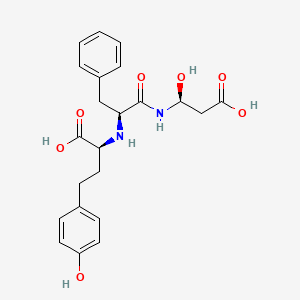
![2-[2-[(6-methoxy-3-methyl-2H-pyrazolo[3,4-b]quinolin-4-yl)amino]ethoxy]ethanol](/img/structure/B1680910.png)
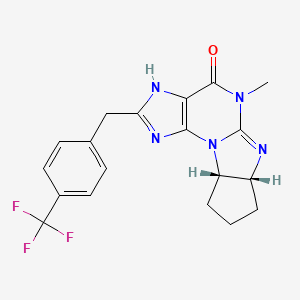
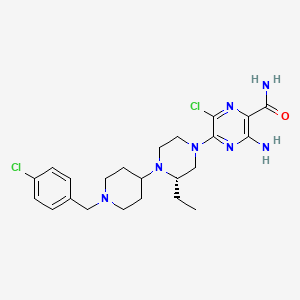
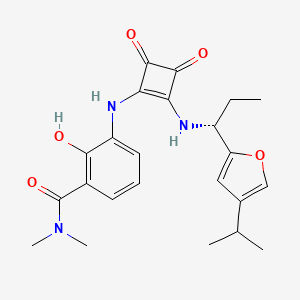
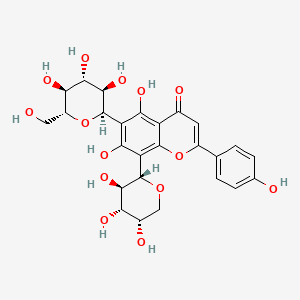
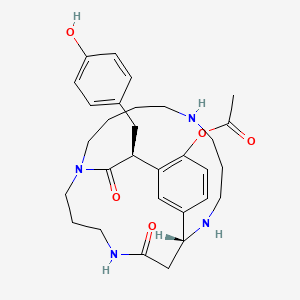
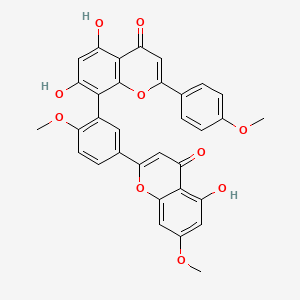
![5-[(3S,8R,9S,10R,13R,14S,17R)-3-[3,5-dihydroxy-6-methyl-4-[3,4,5-trihydroxy-6-(hydroxymethyl)oxan-2-yl]oxyoxan-2-yl]oxy-14-hydroxy-10,13-dimethyl-1,2,3,6,7,8,9,11,12,15,16,17-dodecahydrocyclopenta[a]phenanthren-17-yl]pyran-2-one](/img/structure/B1680924.png)
